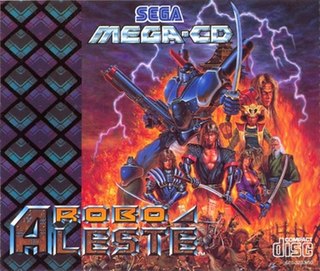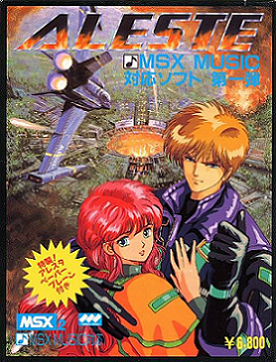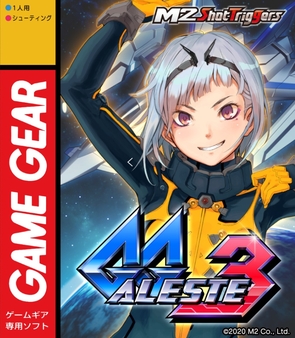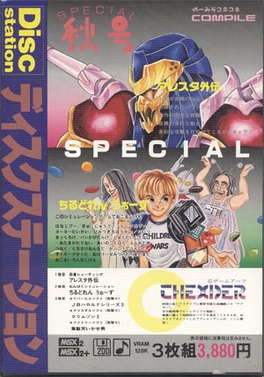
Border Down is a horizontally scrolling shooter video game developed and published by G.rev. It was released in Japanese arcades in April 2003 on Sega NAOMI hardware, and was ported to the Dreamcast later that year. The story takes place in the future where humans are defending their Mars colony from an invading alien attack. The game employs a "border system" where each stage has three variations of different difficulty. The player starts on the easiest variation, and is lowered to a more difficult variation with each subsequent loss of a life.

Dr. Robotnik's Mean Bean Machine is a falling block puzzle video game developed by Compile and published by Sega. It was released for the Sega Genesis / Mega Drive in North America and Europe in November 1993, and ported to the Game Gear in 1993 and Master System in 1994.
Power Strike is a series of vertically scrolling shooter video games, developed by Compile for the Master System and Game Gear. It consists of three titles, only one of which was designed from the ground up as a Power Strike title. The other two are Aleste games re-branded for release outside of Japan.

Robo Aleste, released in Japan as Dennin Aleste (電忍アレスタ), is a 1992 vertically scrolling shooter video game developed and published by Compile for the Sega CD. Tengen and Sega released the English version of the game overseas in 1993. It is a follow-up to MUSHA for the Sega Genesis. A sequel titled Dennin Aleste 2 was planned for the Sega CD on 1993, but was cancelled.

Aleste (アレスタ) is a vertically scrolling shooter developed by Compile, originally published by Sega in 1988 for the Master System and then by CP Communications for the MSX2. The Master System version was released outside Japan as Power Strike. The game spawned the Aleste and Power Strike franchises.
Compile Corporation was a Japanese video game developer, most notable for having developed the Puyo Puyo series, a franchise derived from the Madō Monogatari series. On 6 November 2003, the company shut down amid bankruptcy. As a result, key staff moved to Compile Heart, the company's spiritual successor, whereas shoot-'em-up staff moved to MileStone Inc.

Puyo Puyo! 15th Anniversary is a puzzle video game of the Puyo Puyo series, developed by Sonic Team and published by Sega for the Nintendo DS in 2006, as well as PlayStation 2, PlayStation Portable, and Wii in 2007. It has not been released outside of Japan for any consoles. This is the first Puyo Puyo game to be released on the Wii console.

MUSHA is a vertically scrolling shooter developed by Compile and released for the Sega Genesis in 1990. An entry in Compile's shooter series, Aleste, MUSHA places the player in the role of a flying mecha pilot who must destroy a large super intelligent computer threatening planet Earth. The game had a working title of Aleste 2 and originally featured a style similar to the first game, but this was changed to a more original Japanese aesthetic and speed metal soundtrack.

Xevious: Fardraut Saga is a 1988 vertically scrolling shooter video game published by Namco for the MSX2 in Japan. An updated PC Engine version was released two years later. The fifth entry in the Xevious franchise, the player controls a spaceship in its mission to vanquish the Xevious forces before its supercomputer leader GAMP wipes out the entirety of mankind. The player uses two weapons, an air zapper to destroy air-based enemies, and a blaster bomb to destroy ground-based enemies.

Aleste 2 (アレスタ2) is a scrolling shooter video game developed and released by Compile for the MSX2 in 1989 exclusively in Japan. It is a sequel to Aleste and is the first game in the Aleste series to feature the recurring series heroine Ellinor who later appeared in Musha Aleste. Aleste 2, along with other Compile shooters, was also released for the now-defunct WOOMB service. In 2009, ProjectEGG released the game digitally for Windows, also in English.
Puyo Puyo (ぷよぷよ), previously known as Puyo Pop outside Japan, is a series of tile-matching video games created by Compile. Sega has owned the franchise since 1998, with games after 2001 being developed by Sonic Team. Puyo Puyo was created as a spin-off franchise to Madō Monogatari, a series of first-person dungeon crawler role-playing games by Compile from which the Puyo Puyo characters originated. The series has sold over 10 million copies, including the Madō Monogatari games.

M2 Co., Ltd. is a Japanese video game developer and publisher, best known for handling emulation of re-released games, such as some Sega Ages titles, Virtual Console titles for Nintendo systems, the 3D Classics series for the Nintendo 3DS and their ShotTriggers range of classic STG games. M2 has also created entirely new titles such as WiiWare games for Konami under the ReBirth moniker and more recently a new GG Aleste game. In addition, M2 currently holds the rights of Aleste series and all NEC Avenue and NEC Interchannel games on TurboGrafx-16 and variants, previously owned by Lightweight.

Chaos Field is a 2004 vertically scrolling shooter arcade video game developed by MileStone. The game consists entirely of boss battles, featuring five stages with three bosses each. The player can choose to play as one of three characters, each with their own ship that has a unique primary weapon. The player can flip the environment at will between two parallel worlds.

Seirei Senshi Spriggan is a 1991 vertically scrolling shooter video game developed by Compile and published by Naxat Soft in Japan for the PC Engine CD-ROM². In the game, the player assume control of Jega and Rikart piloting the Spriggan in order to protect their country from the Buraizubara empire.

Power Strike II is a 1993 vertically scrolling shooter video game developed by Compile and published by Sega. Part of the Aleste series, the game takes place across the seas and skies near Italy during the 1930s, with the player assuming the role of a Pothunter piloting the Falcon Flyer aircraft to shoot down sky pirates, former pilots that turned to air piracy for survival as result of the Great Depression in 1929. It retains the same gameplay conventions as the original Power Strike, with the player fighting endless waves of enemies while avoiding collision with their projectiles and other obstacles.

GG Aleste 3 is a 2020 vertically scrolling shooter video game developed and published by M2. It was included as part of the Aleste Collection for Nintendo Switch and PlayStation 4, as well as in a Game Gear Micro variant bundled as part of a limited edition. An entry in the Aleste series, the game follows Luna Waizen, a pilot candidate scrambled into service after destruction of the Moon Child base and fight against cyber terrorists that have seized control of the Earth's satellites. It retains the same gameplay conventions as the original GG Aleste and GG Aleste 2, with the player fighting endless waves of enemies while avoiding collision with their projectiles and other obstacles.

Power Strike II is a 1993 vertically scrolling shooter video game developed by Compile and published by Sega for the Game Gear. An entry in the Aleste series, it is a follow-up to GG Aleste (1991). The game follows Alice Waizen piloting the Lance Bird space fighter craft to stop an unknown parasitic object attached to the armored defense satellite Algo. Its gameplay is similar to the previous Aleste entry on Game Gear, with the player fighting enemies and bosses, while avoiding collision with their projectiles and other obstacles.

Spriggan Mark 2: Re-Terraform Project is a 1992 horizontally scrolling shooter video game developed by Compile and published in Japan by Naxat Soft for the PC Engine Super CD-ROM². It is a follow-up to Seirei Senshi Spriggan (1991). The game follows lieutenant Greg Erwin piloting the armed Bartholomeu armor and later the Spriggan Mark 2 in a war between two opposing forces to decide the fate of a space colony at Mars. The player must fight against waves of enemies to avoid collision with their projectiles and other obstacles, while intermissions between characters during gameplay advances the storyline.

Sylphia is a 1993 vertically scrolling shooter video game developed by Compile and published in Japan by Tonkin House for the PC Engine Super CD-ROM². Whereas many shooting games of the era take place in a science fiction setting, this game instead mixes heroic fantasy and ancient Greek mythology. The game follows Silphia, a maiden warrior reincarnated as a demigoddess under Zeus after her demise in battle, facing against the forces of Hades, who has been possessed and manipulated by the creatures once imprisoned in Tartaros.

Aleste Gaiden is a 1989 vertically scrolling shooter video game developed and published by Compile for the MSX2 home computer. A follow-up to Aleste (1988), it was included as part of the autumn special edition of Disc Station, a monthly disk publication by Compile. It is a sidestory to the main series, taking place in an alternative continuity. Controlling the soldier Raymond Waizen, protagonist of the first game wearing a cybernetic ninja suit, the player must overthrow the supercomputer DIA 51 by fight waves of enemies and bosses, while avoiding collision with their projectiles and other obstacles.


















